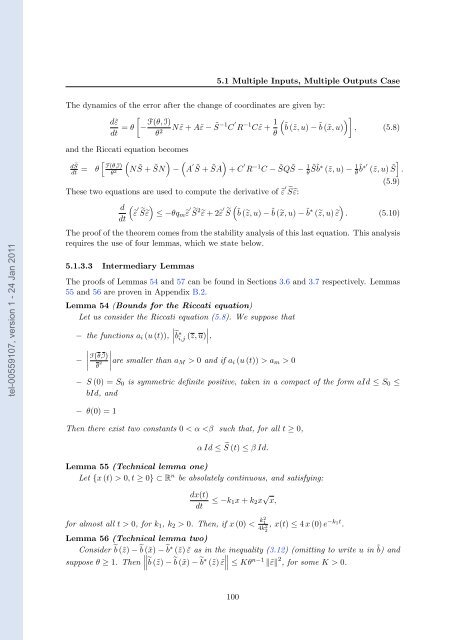Adaptative high-gain extended Kalman filter and applications
Adaptative high-gain extended Kalman filter and applications
Adaptative high-gain extended Kalman filter and applications
You also want an ePaper? Increase the reach of your titles
YUMPU automatically turns print PDFs into web optimized ePapers that Google loves.
tel-00559107, version 1 - 24 Jan 2011<br />
5.1 Multiple Inputs, Multiple Outputs Case<br />
The dynamics of the error after the change of coordinates are given by:<br />
d˜ε<br />
dt<br />
= θ<br />
<strong>and</strong> the Riccati equation becomes<br />
d ˜ S<br />
dt<br />
= θ<br />
� F(θ,I)<br />
θ 2<br />
�<br />
F(θ, I)<br />
−<br />
θ2 N ˜ε + A˜ε − ˜ S −1 C ′<br />
R −1 C ˜ε + 1<br />
� �<br />
˜b (˜z, u) − ˜b (˜x, u)<br />
θ<br />
�<br />
, (5.8)<br />
�<br />
N ˜ S + ˜ SN<br />
�<br />
−<br />
�<br />
A ′ ˜ S + ˜ SA<br />
These two equations are used to compute the derivative of �ε ′ � S�ε:<br />
�<br />
+ C ′<br />
R−1C − ˜ SQ˜ S − 1<br />
θ ˜ S˜b ∗ (˜z, u) − 1<br />
θ ˜b ∗′ (˜z, u) ˜ �<br />
S .<br />
(5.9)<br />
d<br />
�<br />
�ε<br />
dt<br />
′ �<br />
S�ε � ≤−θqm�ε ′ � �<br />
S� 2 ′<br />
�ε +2�ε �S ˜b (�z, u) − ˜b (�x, u) − ˜∗ b (�z, u) �ε . (5.10)<br />
The proof of the theorem comes from the stability analysis of this last equation. This analysis<br />
requires the use of four lemmas, which we state below.<br />
5.1.3.3 Intermediary Lemmas<br />
The proofs of Lemmas 54 <strong>and</strong> 57 can be found in Sections 3.6 <strong>and</strong> 3.7 respectively. Lemmas<br />
55 <strong>and</strong> 56 are proven in Appendix B.2.<br />
Lemma 54 (Bounds for the Riccati equation)<br />
Let us consider the Riccati equation (5.8). We suppose that<br />
�<br />
�<br />
− the functions ai (u (t)), ��b ∗ i,j (z,u)<br />
�<br />
�<br />
�,<br />
−<br />
�<br />
�<br />
�<br />
� F(θ,I)<br />
�<br />
�<br />
�<br />
�are smaller than aM > 0 <strong>and</strong> if ai (u (t)) >am > 0<br />
θ 2<br />
− S (0) = S0 is symmetric definite positive, taken in a compact of the form aId ≤ S0 ≤<br />
bId, <strong>and</strong><br />
− θ(0) = 1<br />
Then there exist two constants 0 < α 0,t≥ 0} ⊂ R n be absolutely continuous, <strong>and</strong> satisfying:<br />
dx(t)<br />
dt ≤−k1x + k2x √ x,<br />
for almost all t>0, for k1, k2 > 0. Then, if x (0) < k2 1<br />
4k2 , x(t) ≤ 4 x (0) e<br />
2<br />
−k1t .<br />
Lemma 56 (Technical lemma two)<br />
Consider �b (˜z) − �b (˜x) − �b ∗ (˜z)˜ε as in the inequality (3.12) (omitting to write u in ˜ �<br />
b) <strong>and</strong><br />
�<br />
suppose θ ≥ 1. Then ��b (˜z) − �b (˜x) − �b ∗ �<br />
�<br />
(˜z)˜ε � ≤ Kθn−1 �˜ε� 2 , for some K>0.<br />
100

















